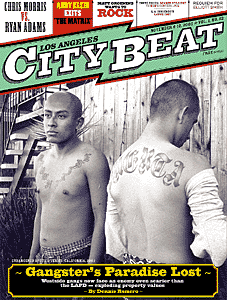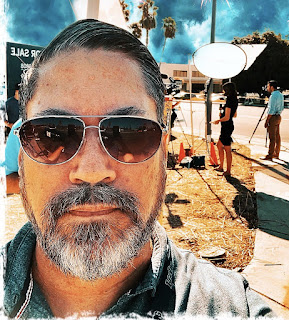Raving Fanatics: Well, 17,254 people can’t be wrong. (Los Angeles Times, Jan. 5, 1993)
Raving Fanatics: Well, 17,254 people can’t be wrong. The all-night party scene has left the underground.
By DENNIS ROMERO
JAN. 5, 1993 12 AM
SPECIAL TO THE TIMES
Destructo is riding high.
He’s at the apex of the Knott’s Berry Farm Timber Mountain log ride, pinned in a fiberglass tree trunk by a gaggle of screaming girls.
It’s his birthday, it’s 2:30 a.m. New Year’s day, and this is his party for 17,254 paying guests--the largest rave yet held in the United States. When he mentioned rave two years ago, he says, “Nobody would listen, not even my mom and dad.”
He steps out of his log, dusts off his black and red wetsuit-look outfit and declares, “Everybody wants to be a kid.”
He’s willing to ride on that, big-time.
Destructo--a.k.a. Gary Richards--helped pull off this coup in hipsterdom, “K-Rave ’93.” A partner in RaveAmerica, which co-produced the party with Knotts, Richards is known for holding all-night dance parties in odd locales. (Waterslide parks are his fave.)
Richards, 22, says today’s youth have a lot of pent-up energy. Maybe that explains the 9 p.m.-to-5 a.m. slot for K-Rave ’93. And, Richards says, young people often feel the need to reach back into a childhood lost. That must explain the unusually heavy sales of Troll dolls at the event.
K-Rave ’93 was assuredly the largest event of its sort ever held in the country, beating the fall “Storm Rave” in New York and last New Year’s “Toontown” rave in San Francisco twice over. Advance sales reached capacity a day before, with the $27.50 tickets being issued at 2,000 per hour at one point.
Ravers from San Diego to Santa Barbara arrived wearing room-for-two jeans, Dr. Seuss top hats and pacifiers around their necks.
Then there were fanatics like the couple who drove from Wisconsin. “Why come here?” said the Wisconsin visitor, Wes Mauer, 22. “Because it’s the party of a lifetime.”
There were six outdoor stages and dance floors lit with lasers, studded with television monitors and marked with move-to-the-music lights. Beams were shining from the park’s trees.
At midnight, the sea of young ravers rushed the stages. There was no icon onstage, however. Not even a live deejay. The music at this point was piped in. It was just the moment.
At other times, the crowd was entertained by Black Sheep, the Movement (which performs techno--a form of electronic punk rock that is the staple music of raves), a half-dozen minor acts and the top techno deejays from Los Angeles and New York.
“Those kids out there aren’t drunk and they aren’t on drugs,” said Richards. “Those kids are high on music and life.”
Indeed, rave culture, long based on the neo-cynicism fostered at illicit warehouse parties, is coming out of the closet. And coming clean.
Drugs were scarce inside the park on New Year’s Eve, although two dealers did a brisk business outside the walls, and the party was liquor-free.
Knott’s officials were patient as about 10,000--many without tickets--milled around outside, as about 150 attempted to crash the gates and as there was one brawl inside and another outside resulting in a minor injury.
Knott’s (along with everyone and their mother in the culture industry, it seems) wants a bigger piece of this action. With its own music, clothing and free thinking, some culture watchers expect the rave scene to explode this spring in a way not seen since the ‘60s counterculture or the days of punk rock.
East Coast promoters are talking about holding a “Ravestock” this spring near the Upstate New York site of Woodstock, Richards said.
“This is the most tickets we have ever sold for a New Year’s Eve event,” said Knott’s spokesman Stuart A. Zanville. “We are tentatively planning to do another one in spring. And what we would eventually like to see is one maybe every three months.”
In the future, Knott’s plans to tread this savvy culture without the help of Richards and his partner in RaveAmerica, Paul (Paradise) Sansone, a radio veteran and marketing director at the pop station KPWR-FM.
The two promoters say a solo mission by Knott’s is a mistake because raves need figures like Destructo and Paradise for credibility. But they have other plans.
Richards and Sansone say they intend to take mega-raves across the nation as a form of multimedia entertainment that could replace the traditional concert. Rave-America events would feature a smorgasbord of music acts and deejays and would coordinate the events with the leaders of the local rave scenes.
Richards, who was just hired by Def American records head and hip-hop visionary Rick Rubin to scout rave-music acts, explains the break with entertainment’s past: “You go to a movie or a concert and you get fed ideas. You come to a rave and you come up with your own ideas.”
But Rick Cummings, program director of KPWR, says rave will become just another player in an increasingly fragmented world of youth culture: “Kids are looking for extremes--like Ice-T and Body Count.
“From hard rock to hip-hop, what you’re dealing with is basically that young people like to piss their parents off,” Cummings says.
Destructo is oblivious to this sort of talk. He’s riding high again at his party, atop a third-floor stage, helping New York deejay Joey Beltram start up the turntables.
“This is what’s going to happen,” he says to Beltram as the audience screams in anticipation. “We’re going to play it hard and loud until they tell us to turn it down.”
By DENNIS ROMERO
JAN. 5, 1993 12 AM
SPECIAL TO THE TIMES
Destructo is riding high.
He’s at the apex of the Knott’s Berry Farm Timber Mountain log ride, pinned in a fiberglass tree trunk by a gaggle of screaming girls.
It’s his birthday, it’s 2:30 a.m. New Year’s day, and this is his party for 17,254 paying guests--the largest rave yet held in the United States. When he mentioned rave two years ago, he says, “Nobody would listen, not even my mom and dad.”
He steps out of his log, dusts off his black and red wetsuit-look outfit and declares, “Everybody wants to be a kid.”
He’s willing to ride on that, big-time.
Destructo--a.k.a. Gary Richards--helped pull off this coup in hipsterdom, “K-Rave ’93.” A partner in RaveAmerica, which co-produced the party with Knotts, Richards is known for holding all-night dance parties in odd locales. (Waterslide parks are his fave.)
Richards, 22, says today’s youth have a lot of pent-up energy. Maybe that explains the 9 p.m.-to-5 a.m. slot for K-Rave ’93. And, Richards says, young people often feel the need to reach back into a childhood lost. That must explain the unusually heavy sales of Troll dolls at the event.
K-Rave ’93 was assuredly the largest event of its sort ever held in the country, beating the fall “Storm Rave” in New York and last New Year’s “Toontown” rave in San Francisco twice over. Advance sales reached capacity a day before, with the $27.50 tickets being issued at 2,000 per hour at one point.
Ravers from San Diego to Santa Barbara arrived wearing room-for-two jeans, Dr. Seuss top hats and pacifiers around their necks.
Then there were fanatics like the couple who drove from Wisconsin. “Why come here?” said the Wisconsin visitor, Wes Mauer, 22. “Because it’s the party of a lifetime.”
There were six outdoor stages and dance floors lit with lasers, studded with television monitors and marked with move-to-the-music lights. Beams were shining from the park’s trees.
At midnight, the sea of young ravers rushed the stages. There was no icon onstage, however. Not even a live deejay. The music at this point was piped in. It was just the moment.
At other times, the crowd was entertained by Black Sheep, the Movement (which performs techno--a form of electronic punk rock that is the staple music of raves), a half-dozen minor acts and the top techno deejays from Los Angeles and New York.
“Those kids out there aren’t drunk and they aren’t on drugs,” said Richards. “Those kids are high on music and life.”
Indeed, rave culture, long based on the neo-cynicism fostered at illicit warehouse parties, is coming out of the closet. And coming clean.
Drugs were scarce inside the park on New Year’s Eve, although two dealers did a brisk business outside the walls, and the party was liquor-free.
Knott’s officials were patient as about 10,000--many without tickets--milled around outside, as about 150 attempted to crash the gates and as there was one brawl inside and another outside resulting in a minor injury.
Knott’s (along with everyone and their mother in the culture industry, it seems) wants a bigger piece of this action. With its own music, clothing and free thinking, some culture watchers expect the rave scene to explode this spring in a way not seen since the ‘60s counterculture or the days of punk rock.
East Coast promoters are talking about holding a “Ravestock” this spring near the Upstate New York site of Woodstock, Richards said.
“This is the most tickets we have ever sold for a New Year’s Eve event,” said Knott’s spokesman Stuart A. Zanville. “We are tentatively planning to do another one in spring. And what we would eventually like to see is one maybe every three months.”
In the future, Knott’s plans to tread this savvy culture without the help of Richards and his partner in RaveAmerica, Paul (Paradise) Sansone, a radio veteran and marketing director at the pop station KPWR-FM.
The two promoters say a solo mission by Knott’s is a mistake because raves need figures like Destructo and Paradise for credibility. But they have other plans.
Richards and Sansone say they intend to take mega-raves across the nation as a form of multimedia entertainment that could replace the traditional concert. Rave-America events would feature a smorgasbord of music acts and deejays and would coordinate the events with the leaders of the local rave scenes.
Richards, who was just hired by Def American records head and hip-hop visionary Rick Rubin to scout rave-music acts, explains the break with entertainment’s past: “You go to a movie or a concert and you get fed ideas. You come to a rave and you come up with your own ideas.”
But Rick Cummings, program director of KPWR, says rave will become just another player in an increasingly fragmented world of youth culture: “Kids are looking for extremes--like Ice-T and Body Count.
“From hard rock to hip-hop, what you’re dealing with is basically that young people like to piss their parents off,” Cummings says.
Destructo is oblivious to this sort of talk. He’s riding high again at his party, atop a third-floor stage, helping New York deejay Joey Beltram start up the turntables.
“This is what’s going to happen,” he says to Beltram as the audience screams in anticipation. “We’re going to play it hard and loud until they tell us to turn it down.”


